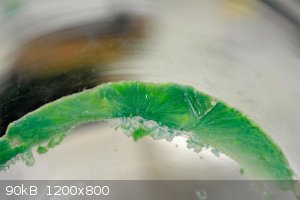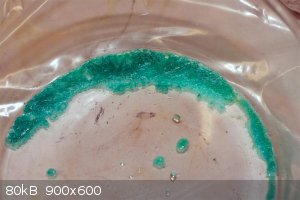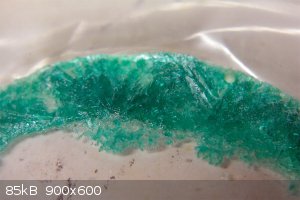| Pages:
1
2 |
S.C. Wack
bibliomaster
    
Posts: 2419
Registered: 7-5-2004
Location: Cornworld, Central USA
Member Is Offline
Mood: Enhanced
|
|
Under what conditions if any can nickels and hydrogen reduce nitrate? Or something else...not all of it, but some. Or another form of Ni...not that
it's particularly known for dissolving metal reductions...but I'm open to the possibility.
[Edited on 3-9-2018 by S.C. Wack]
|
|
|
Sulaiman
International Hazard
    
Posts: 3558
Registered: 8-2-2015
Location: 3rd rock from the sun
Member Is Offline
|
|
* Please bear in mind that I have no nickel chemistry experience
My first experiments left me with 16.4 grams of "product". This is a bit odd to me as the nickel only weighed approx 3.5 grams. Further, .74 grams
weren't dissolved.
* (Nickel nitrate hexahydrate) / (Nickel) = 290.79 / 58.69 = 4.954
(3.5 - .74) x 4.954 = 13.675 g nickel nitrate hexahydrate expected.
The rest is probably 'wetness'
The test tubes contain, from left to right, toluene, acetone, and ethanol (95%). I dissolved 2 grams (of that aforementioned substance), one gram at
a time into 2ml of distilled water. The first gram dissolved easily in less than 15 seconds. The second gram took nearly a minute to be stirred into
solution. I assumed I was close to the saturation point with this solution.
I added this solution, drop wise, to the three test tubes.
* This could be a problem. You need dry crystals
(not necessarily, but possibly nearer to, anhydrous. No adhering moisture)
Add the dry crystals to anhydrous solvent for crystallisation by evaporation.
|
|
|
JScott
Hazard to Self
 
Posts: 51
Registered: 23-8-2018
Member Is Offline
|
|
Today I dissolved the nickel product I had made in the three aforementioned solvents. I was in the lab before I got to the forum so I hadn't seen the
more recent comments.
As many had no doubt guessed it wouldn't dissolve in toluene. It dissolved in the Ethanol but was in solution in acetone more quickly.
5 ml of acetone at room temp just barely dissolved one gram. At boiling I could get another 2 grams to dissolve, so I thought perhaps as it cooled,
given a dry enough environment I might see something promising.
Nothing at this point, but a night of drying... who knows?
@Sulaiman,
As I was taking my notes today and I wrote in 95% Ethanol I realized that with everything I had read since coming to the forum, that was not dry
enough. And I could tell looking at the dark areas in the product I had made, it wasn't dry enough either.
The talk of a Dean Stark trap reminded me my Toluene and acetone weren't all that dry either.
I would also like to correct something I had said earlier in the post about it not attracting water and leaving a wet area like Calcium Chloride does.
That was wrong, it most certainly does act that way. I think I had bottled it up from dry bags or desiccators quickly enough to have not noticed that
before. Today in the lab, as I slowly added more of the product to the acetone, it absorbed water as I watched.
Reading more about how those crystals are formed I see that very toxic nickel species are normally employed. So, I am trying to live with the fact
that I may have to end my experiments without realizing my ultimate goal (translucent green crystals).
However, I have created enough 'nickle product' to do a few more experiments and will continue at least until I have used my current stock.
@S.C. Wack,
Sorry, I'm not entirely clear what you are asking me. I am a new student, just learned how to balance equations a week ago. Lewis structures today.
The last two labs have left me a few things still drying. I'll back to everyone on that in the morning.
|
|
|
JScott
Hazard to Self
 
Posts: 51
Registered: 23-8-2018
Member Is Offline
|
|
Interesting, and a partial success!
3 grams of the Nickel compound I have been assuming was Nickel II Nitrate, dissolved it in 5ml of acetone just at the boiling point. Cooled and dried
overnight in a bag with Calcium Chloride. I understand now that as a desiccant, it may be less absorptive than my product, but I had to stop for the
day and need the driest place possible to leave the still fluid acetone mixture.
Cooling alone did not produce these. My thinking is that the Chloride was able to pull some water from the acetone overnight. These crystals of the
substance I've been working with don't have the same geometry of the Nickle II crystals on the wiki. But, at this point, to see any crystals of the
correct color is a thrill!
I also note some white/clear crystals, different shape. Given the color is different this is not an example of polymorphic crystallization, correct?
It would be a different compound?
Here again, forgive any of my amateur assumptions, I have only been studying a short time. OK, so the photo:

[Edited on 9-4-2018 by JScott]
[Edited on 9-4-2018 by JScott]
|
|
|
JScott
Hazard to Self
 
Posts: 51
Registered: 23-8-2018
Member Is Offline
|
|
3Ni + 8HNO3 → 3Ni(NO3)2 + 2NO + 4H2O
I looked this up, I had written it more simply with just one mole of Ni acting on one mole of acid. Assuming I had the hexahydrate form given what I
had read, I wondered where the rest of formula came from. The oxide was easy enough to imagine, but the water wasn't as obvious to me.
Ni + HNO3 → Ni(NO3)2 I couldn't have hoped to balance that off course.
I have just finished reading about the nickle oxide and water.
While reading I learned a great deal more about metal salts and their formation. Thank you for your patience regarding my early steps here.
Any ideas regarding why my crystals look like they do? What are the clear/white crystals? Are they Nickle oxide?
My next attempt forming Nickel Nitrate will be via Nickle oxide, rather than the beaver coin. Researching various routes to nickle oxide I came across
this:
A Versatile Route for the Synthesis of Nickel Oxide Nanostructures Without Organics at Low Temperature
Could a temperature compensated reflux setup that held the same temperature accomplish the same thing as the autoclave did under these circumstances?
I would image if that route could have been taken that's what they would have done. Anyhow, off to make some nickel oxide.
I will continue to work on the crystals I have formed by crystallizing my nitrate out of acetone. At the same time trying out this other idea.
[Edited on 9-5-2018 by JScott]
[Edited on 9-5-2018 by JScott]
[Edited on 9-5-2018 by JScott]
|
|
|
Sulaiman
International Hazard
    
Posts: 3558
Registered: 8-2-2015
Location: 3rd rock from the sun
Member Is Offline
|
|
Quote: Originally posted by JScott  | | I also note some white/clear crystals, different shape. Given the color is different this is not an example of polymorphic crystallization, correct?
It would be a different compound? |
I do not know what the white crystaline stuff is,
but dehydrating copper sulphate gives white crystals,
and I notice that the green crystals do not seem to be very hygroscopic or deliquescent,
so, if the white crystals slowly turn green, they may just be a less hydrated form of nickel nitrate.
If they stay white then I suspect some contamination/impurities.
|
|
|
JScott
Hazard to Self
 
Posts: 51
Registered: 23-8-2018
Member Is Offline
|
|
Quote: Originally posted by Sulaiman  | Quote: Originally posted by JScott  | | I also note some white/clear crystals, different shape. Given the color is different this is not an example of polymorphic crystallization, correct?
It would be a different compound? |
I do not know what the white crystaline stuff is,
but dehydrating copper sulphate gives white crystals,
and I notice that the green crystals do not seem to be very hygroscopic or deliquescent,
so, if the white crystals slowly turn green, they may just be a less hydrated form of nickel nitrate.
If they stay white then I suspect some contamination/impurities. |
I thought impurities as well. Given the coin was carefully cleaned, that leaves only one good route I can think of. I synthesized the acid from Stump
remover and drain cleaner. I recrystallized the stump remover and distilled the drain cleaner (scary for a noob). So what would your best guess be for
contaminants?
I haven't looked up what Nickle oxide looks like, but the formula tells me it's there. I do see I end up with 2 moles of oxide when all is said and
done. Would I see that?
Sorry for the continuous edits, I had forgot to mention that after another 24 hours of desiccation there are more small white (square) crystals. In
fact, very small ones cover the green needle like one still laying as you see them in the photo. I assume that photo shows needle like structures that
will break apart when I scrape them from the dish.
I'll get another photo later to today.
[Edited on 9-5-2018 by JScott]
|
|
|
JScott
Hazard to Self
 
Posts: 51
Registered: 23-8-2018
Member Is Offline
|
|
After ten more days on the desiccant most of the crystals have reverted to the dark green form seen here. The change in color is fairly accurate. The
white crystals thought to be contaminant became green after continued desiccation, so I would imagine they are the same substance but with more (or
less) water.
Also the shade of green has clearly changed in the days since the first photos were taken.
Thanks for all of your advice getting me this far.
@S.C. Wack,
I am here to learn. I want to understand your question, if you have a minute, drop me another line.
 
[Edited on 9-19-2018 by JScott]
|
|
|
S.C. Wack
bibliomaster
    
Posts: 2419
Registered: 7-5-2004
Location: Cornworld, Central USA
Member Is Offline
Mood: Enhanced
|
|
The question wasn't directed at anyone except for someone who might know. There is a short list of cpds. one can obtain from air, water, nitric acid,
and .999 nickel...until it occurred to me that reduction is not impossible, under strange circumstances or not.
|
|
|
| Pages:
1
2 |